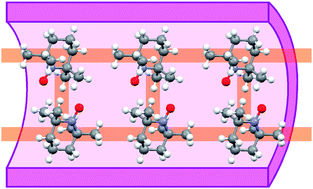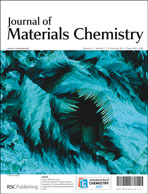A series of S = ½ organic radicals—TEMPO (TEMPO = 2,2,6,6-tetramethylpiperidine-1-oxyl), 4-methoxy-TEMPO, and 4-oxo-TEMPO—have been included in the cavities of porous lamellar host frameworks constructed from guanidinium (G) cations and organodisulfonate (DS) anions, which assemble into hydrogen-bonded guanidinium sulfonate (GS) sheets connected by organodisulfonate pillars that create cavities between the sheets. The pillars can project above or below the GS sheet in different configurations, affording various architectural framework isomers whose selectivity is determined by the relative sizes of the guests and the pillars. Each framework isomer is endowed with uniquely sized and shaped cavities, which influence the molecular arrangement of the radical guests included within the host lattice. Notably, TEMPO guests in the 1-D channels of simple brick G22BPDShost (BPDS = biphenyl-4,4′-disulfonate) arrange as a two-leg ladder (a chain of dimers), whereas TEMPO guests in the cavities of zigzag brick G22NDShost (NDS = naphthalene-2,6-disulfonate) form dimers that are distributed into a 2-D square-planar lattice. The high-temperature magnetic susceptibility, χmol, conformed with Curie–Weiss behavior, with negative Weiss constants, consistent with bulk antiferromagnetic ordering. The Néel temperatures (TN) for G22BPDS·2(TEMPO) and G22NDS·2(TEMPO) were found to be 3.83 K and 4.10 K, respectively, as indicated by the presence of a broad maximum in χmol near these temperatures. In contrast, TN for host-free crystalline TEMPO is lower at 2.3 K, suggesting that enforced ordering can alter the magnetic properties of the TEMPO guests. The low-temperature χmol data for G22BPDS·2(TEMPO) agreed well with the Troyer two-leg ladder spin model, with J/kB = −7.29 K along the rungs of the ladder (intra-dimer) and J/kB = −0.45 K along the legs of the ladder (inter-dimer). The χmol data for G22NDS·2(TEMPO) agreed best with Bleaney–Bowers behavior for isolated dimers with J/kB = −3.31 K for the encapsulated TEMPO dimer. These results demonstrate that magnetic behavior, including dimensionality, can be manipulated through judicious selection of host and magnetic guests.


 Please wait while we load your content...
Please wait while we load your content...